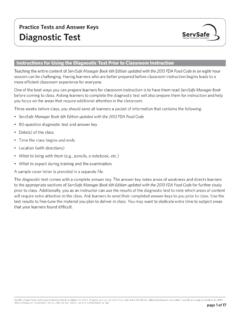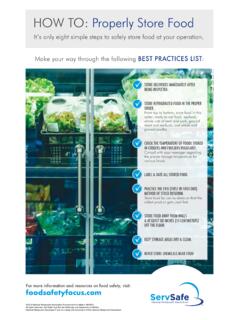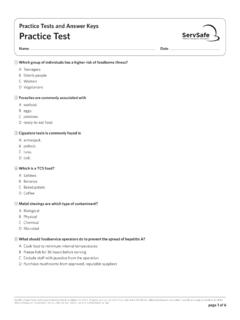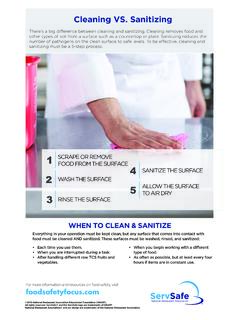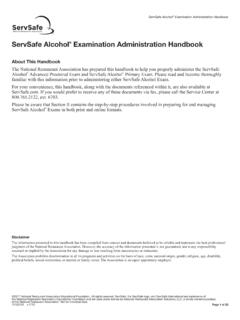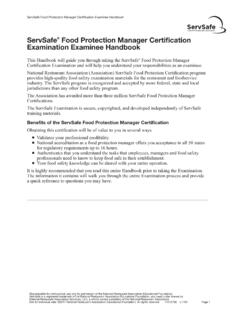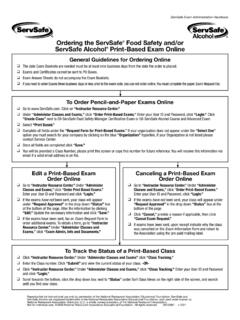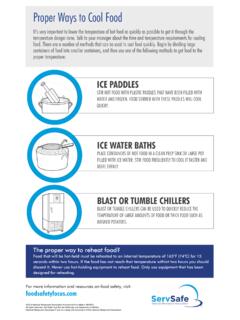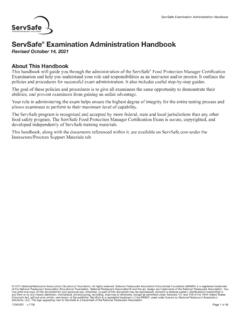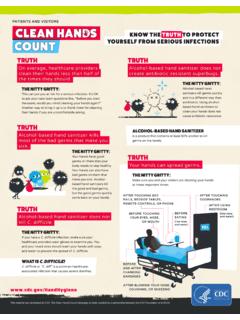Transcription of Week 3: Cleaning and Sanitizing Practices That Will ...
1 Be Safe, Don't Cross-Contaminate Week 3: Cleaning and Sanitizing Practices That Will Prevent Cross-Contamination No matter how carefully food is cooked, without a clean and sanitized environment, pathogens can be quickly transferred to both cooked and uncooked food. To prevent cross-contamination from surfaces, the correct Cleaning and Sanitizing procedures must be followed. Cleaning and Sanitizing Food-contact surfaces must be both cleaned and sanitized correctly. yyCleaning removes food and other dirt from a surface. yySanitizing reduces pathogens on a surface to safe levels. How Cross-Contamination Can Occur Pathogens can spread to food if equipment has not been cleaned and sanitized correctly. This can happen in the following ways. yyEquipment and utensils are not washed, rinsed, and sanitized between uses. yyFood-contact surfaces are wiped clean rather than being washed, rinsed, and sanitized. yyWiping cloths are not stored in a sanitizer solution between uses. yySanitizing solutions are not at the required levels to sanitize objects.
2 2012 National Restaurant Association Educational Foundation (NRAEF). All rights reserved. ServSafe is a registered trademark of the NRAEF, used under license by National Restaurant Association Solutions, LLC. The logo appearing next to ServSafe is a registered mark of the National Restaurant Association. Be Safe, Don't Cross-Contaminate Week 3: Cleaning and Sanitizing Practices That Will Prevent Cross-Contamination How and When to Clean and Sanitize Any surface that touches food, such as knives, stockpots, cutting boards, and prep tables, must be cleaned and sanitized. To clean and sanitize a surface, follow these steps. 1 2. Scrape or remove food Wash the surface. bits from the surface. 3 4. Rinse the surface. Sanitize the surface. 5 Allow the surface to air-dry. All food-contact surfaces must be cleaned and sanitized after they are used; before food handlers start working with a different type of food; any time food handlers are interrupted during a task and the items being used may have been contaminated; and after four hours if items are in constant use.
3 2012 National Restaurant Association Educational Foundation (NRAEF). All rights reserved. ServSafe is a registered trademark of the NRAEF, used under license by National Restaurant Association Solutions, LLC. The logo appearing next to ServSafe is a registered mark of the National Restaurant Association. Be Safe, Don't Cross-Contaminate Week 3|Activity 1: T. o Sanitize or Not To Sanitize Directions: Place an X next to each situation that requires the food handler to clean and sanitize the item being used. 1. Catalina has used the same knife to shuck oysters for 2 hours. 2. Justin finishes filleting fish and wants to use the same cutting board to chop onions. 3. Cary is deboning a chicken. She is interrupted to help receive a shipment and leaves her dirty knife and cutting board for an hour while other people are working around it. 4. Armaan uses the same knife and cutting board to chop meat for an hour. He then switches to a new, clean and sanitized knife and cutting board to debone chicken.
4 5. Brian has been using the same slicer to slice ham on and off for 6 hours. 2012 National Restaurant Association Educational Foundation (NRAEF). All rights reserved. ServSafe is a registered trademark of the NRAEF, used under license by National Restaurant Association Solutions, LLC. The logo appearing next to ServSafe is a registered mark of the National Restaurant Association. Be Safe, Don't Cross-Contaminate Week 3|Activity 2: W. hich is the Correct Practice? Directions: Place an X next to each action that can spread pathogens from the body to food. Store wiping cloths in apron pockects Store wiping cloths in a sanitizer solution Wipe the food-contact surface clean Wash the food-contact surface 2012 National Restaurant Association Educational Foundation (NRAEF). All rights reserved. ServSafe is a registered trademark of the NRAEF, used under license by National Restaurant Association Solutions, LLC. The logo appearing next to ServSafe is a registered mark of the National Restaurant Association.
